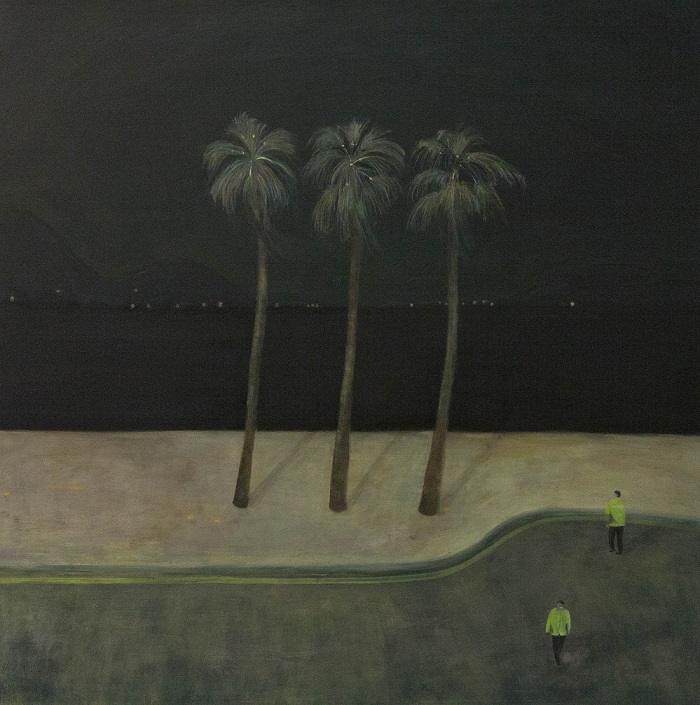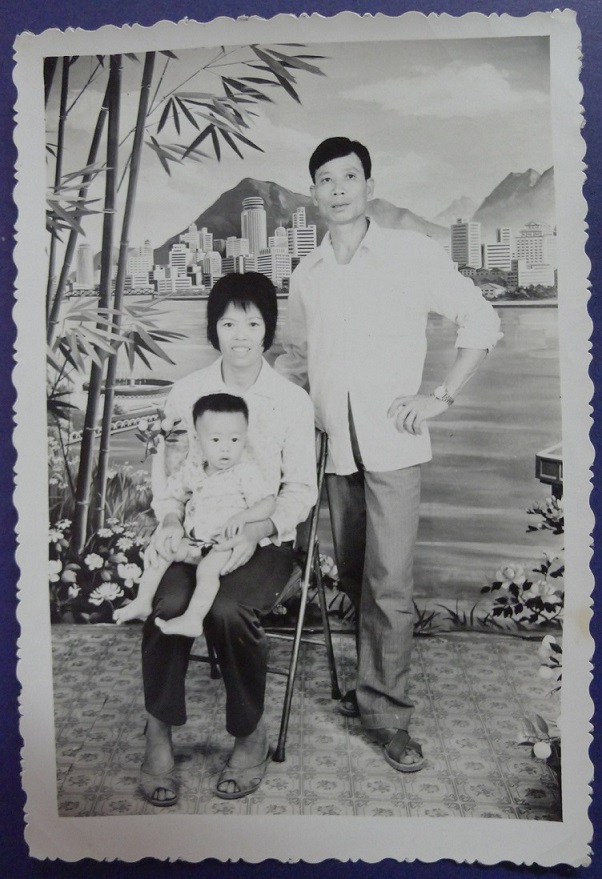Reviews & Articles
沒有實現的現代主義海濱夢 | A Failed Modernist Waterfront Dream
John BATTEN
at 6:20pm on 10th June 2018


圖片說明 Captions:
1. 九龍城碼頭被破壞的棕櫚樹,2018年4月(攝影:約翰百德)。 Destroyed palm trees, Kowloon City Ferry Pier, April 2018 (photograph: John Batten)
2. 黃美諺的《沒有旅行團的碼頭》,2018(照片由藝術家提供)。 Wong Mei Yin’s The Pier Without Tour Groups, 2018 (photograph courtesy of the artist).
3. 影廊照片拾遺,相中的父母和子女站在手繪香港海濱場景前,約1950年代。 Found studio photograph of parents and child in front of a painted Hong Kong waterfront scene, circa 1950s.
(Please scroll down for English version)
我最近出席了由 《Perspective 》建築雜誌舉辦,有關香港海濱的座談會。當一眾建築師看到發展機會,我(很不幸地)卻在席上提到未能實現的希望。如果你晚上站在山頂眺望,會看到一片璀璨風景:由高樓大廈、耀目燈光和閃閃生輝的海港構成。但如果你身在地面,站於高樓之間又或海港之旁,那種美態便會被路邊的污染和交通擠塞淹沒。要在海傍難找到可供站立之地並可謂 可遇不可求,因為佔據海濱大部份範圍的,是道路、公用設施和貨倉,而不是令人放輕鬆的公園、種滿樹木的行人步道或單車徑。下圖一幀拍下父母和孩子的拾遺照片來自1950年代,它的背景刻劃了香港的現代主義海濱夢:有山、有水,也有不少建築物,預視著今天的香港。可惜,這個夢卻因為零碎和冷漠不仁的規劃,最終未能達成。
灣仔富德樓頂樓是艺鵠的書店和辦事處。富德樓內很多單位都由一位匿名捐助人持有,他透過慈善基金,慷慨地讓藝術家以低廉的租金用作工作室,以及非牟利文化組織的辦公室,另類新聞網站香港獨立媒體網(Inmedia)的辦公室也在這裡。
艺鵠管理各個單位,並在頂樓書店舉辦講座,在六樓畫廊辦展覽。我最近拜訪了艺鵠其中一個定期開放的工作室周末,並走進了暫時化身展覽空間的工作室。我在其中一個工作室與黃美諺見面,她與另外三位舊同學藝術家共享一個工作室。她給我看了一幅謎一樣的畫作,以香港海港夜景為題,上面畫上了遙遠的燈光、三棵枝葉稀疏的棕櫚樹,和兩個人物。作品流露著神秘氣息,令人聯想到法國藝術家亨利.盧梭或諾埃爾.麥肯納。作品的標題是《沒有旅行團的碼頭》,展現畫作背後對於海港入夜風景較深層次的關注。
黃氏的畫作刻劃了我熟悉的地方。到土瓜灣牛棚參觀藝術展覽,最快和最令人享受的方法,便是由北角乘坐渡輪過海前往九龍城碼頭,再走一陣便可到達牛棚。在港鐵海底隧道仍未開通的年代,這一程小輪便是區內居民過海的唯一方法。那段日子的舊有足跡至今尚存:舊式巴士亭、告示牌和前汽車渡輪碼頭的破爛石屎斜台。毫無裝飾的石屎前院和幾盆零落的盆裁是1960年代典型的實用園景設計。然而,海濱的50米外,在巴士站牌之間,卻是一個小小的草地範圍,長有三棵非常高的成熟棕櫚樹。在荒蕪的支線道路和巴士站之間,牠們看上去就像哨兵一樣。藝術家把棕櫚樹繪畫成區內的熟悉圖騰。在數以百萬計多年內與它們朝夕相見的通勤市民眼中,這三棵棕櫚樹正正喚起了那些無數往來船程的回憶。
黃氏告訴我這三棵樹剛於上星期被砍掉。我特意前往該處看看,對這種沒有道理可言的破壞大感震驚。路政署無疑是為了擴建新的旅遊巴士泊車處才把樹砍下。
九龍城碼頭旁邊正是馬頭角公眾碼頭,每晚都有數以千計的內地廉遊旅客在碼頭附近聚集,由小艇接載(有些看上去非常搖擺不定),然後送到鯉魚門附近的海鮮餐館。旅客乘坐旅遊巴到來,巴士停泊在前巴士總站前院。黃氏的棕櫚樹於50年前種下,只消數分鐘便被路政署以電鋸砍掉,騰出空間用來停泊多兩部旅遊巴士。
香港的海濱長久以來都飽受各政府部門的剝奪態度煎熬。在漠不關心的發展中,樹木是多餘的;當海港本身沒有得到適當照料,樹木更是無關痛癢的。黃氏的畫作更令人神傷之處,是棕櫚樹已經消失了,而兩個身穿反光綠色背心的男子,正小心地指導巴士進入新的泊車處。
參考資料:
www.aco.hk
www.wongmeiyinoo.com
原文刊於《明報周刊》,2018年6月9日
A Failed Modernist Waterfront Dream
by John Batten
I was recently a panelist discussing Hong Kong’s waterfront at a forum organized by Perspective architectural magazine. Whereas architects saw development opportunities, I (unfortunately) talked about unfulfilled hopes. If you stand at the lookout on The Peak at night the view is of magnificent tall buildings, sparkling lights and a glistening harbour. But, if you stand at ground-level amongst those buildings or alongside the harbour, that beauty is consumed by roadside pollution and congestion. And, finding a place to stand beside the harbour is a rarity: much of the waterfront is occupied by roads, utilities and warehouses – not relaxing parks or tree-lined footpaths or bicycle tracks. The found 1950s photograph of parents and child (see below) also depicts Hong Kong as a modernist waterfront dream of mountains, water and buildings anticipating today’s Hong Kong. But, it is largely a failed dream due to piecemeal uncaring planning.
On the top floor of the Foo Tak building in Wan Chai is the bookshop and office of Art and Culture Outreach (ACO). Many units in the Foo Tak building are owned by an anonymous benefactor who, through a charitable foundation, generously allows at low rental their use to artists for artist studios, and as offices for non-profit cultural organisations, including the alternative news website, Inmedia.
ACO manages the units and hosts talks in the top-floor bookshop and exhibitions in their sixth floor gallery. I recently visited one of ACO’s regular open studio weekends, and popped into studios temporarily converted into exhibition spaces. In one of the studios I spoke to Hazel Wong Mei Yin, who shares a studio with three artist friends who had previously studied together. She showed me an enigmatic night-time painting of Hong Kong harbour with distant lights, three stark palm trees and two figures. It had a mystical feeling, reminiscent of the French artist Henri Rousseau or the Australian Noel McKenna. The painting’s title, The Pier Without Tour Groups, indicates a deeper concern than the painting’s obvious representation of a night-time harbour landscape.
Wong’s painting depicted a place I knew well. The quickest and most enjoyable way to visit art exhibitions at the Cattle Depot in Tokwawan is to catch a ferry from North Point, crossing the harbour to the Kowloon City ferry pier; it is then a short walk to the Cattle Depot. In the days before the cross-harbour tunnel and the MTR, this journey would have been the only way for the area’s residents to cross the harbour. The remnants of that time are still there: old-style bus shelters, signage and the ruined concrete ramps of the former vehicular ferry. The bare concrete forecourt and a few straggly pot plants is typical of pragmatic 1960s landscaping. However, fifty metres from the waterfront amongst the bus-stands was a small grassed area and three very tall, mature palm trees. They had a sentinel-like appearance amongst the barren feeder roads and bus stops. The artist had painted them as a familiar totem for the area. These three palm trees were, for the millions of commuters that had seen them over the years, an evocative reminder of those countless past trips.
Wong told me they had just been cut down the previous week. I went to look and was also shocked by the wanton destruction. The Highways Department had cut them down as part of the Central Kowloon Route road project linking Yau Ma Tei to Kai Tak, and undoubtably, to extend the parking area for tourist buses.
Next to the Kowloon City ferry pier is the Ma Tau Kok public pier and every night thousands of mainland budget tourists congregate near the pier and are met by small boats (some looking very unstable), then taken to seafood restaurants near Lei Yue Mun. The tourists arrive by bus which park in the former bus terminal forecourt. Wong’s palm trees, planted fifty years ago, were felled in minutes by a Highways Department chainsaw, giving two more tourist buses a parking space.
Hong Kong’s harbourfront has long-suffered by such rapacious attitudes by government agencies. Trees are surplus to the needs of uncaring development and irrelevant when the harbour itself is uncared for. Wong’s painting is sadder still: the palm trees have gone and two men in reflective green vests are carefully directing buses to park.
Link for further info:
www.aco.hk
www.wongmeiyinoo.com
www.ckr-hyd.hk
This article was originally published in Ming Pao Weekly on 9 June 2018, translated by Aulina Chan.
1. 九龍城碼頭被破壞的棕櫚樹,2018年4月(攝影:約翰百德)。 Destroyed palm trees, Kowloon City Ferry Pier, April 2018 (photograph: John Batten)
2. 黃美諺的《沒有旅行團的碼頭》,2018(照片由藝術家提供)。 Wong Mei Yin’s The Pier Without Tour Groups, 2018 (photograph courtesy of the artist).
3. 影廊照片拾遺,相中的父母和子女站在手繪香港海濱場景前,約1950年代。 Found studio photograph of parents and child in front of a painted Hong Kong waterfront scene, circa 1950s.
(Please scroll down for English version)
我最近出席了由 《Perspective 》建築雜誌舉辦,有關香港海濱的座談會。當一眾建築師看到發展機會,我(很不幸地)卻在席上提到未能實現的希望。如果你晚上站在山頂眺望,會看到一片璀璨風景:由高樓大廈、耀目燈光和閃閃生輝的海港構成。但如果你身在地面,站於高樓之間又或海港之旁,那種美態便會被路邊的污染和交通擠塞淹沒。要在海傍難找到可供站立之地並可謂 可遇不可求,因為佔據海濱大部份範圍的,是道路、公用設施和貨倉,而不是令人放輕鬆的公園、種滿樹木的行人步道或單車徑。下圖一幀拍下父母和孩子的拾遺照片來自1950年代,它的背景刻劃了香港的現代主義海濱夢:有山、有水,也有不少建築物,預視著今天的香港。可惜,這個夢卻因為零碎和冷漠不仁的規劃,最終未能達成。
灣仔富德樓頂樓是艺鵠的書店和辦事處。富德樓內很多單位都由一位匿名捐助人持有,他透過慈善基金,慷慨地讓藝術家以低廉的租金用作工作室,以及非牟利文化組織的辦公室,另類新聞網站香港獨立媒體網(Inmedia)的辦公室也在這裡。
艺鵠管理各個單位,並在頂樓書店舉辦講座,在六樓畫廊辦展覽。我最近拜訪了艺鵠其中一個定期開放的工作室周末,並走進了暫時化身展覽空間的工作室。我在其中一個工作室與黃美諺見面,她與另外三位舊同學藝術家共享一個工作室。她給我看了一幅謎一樣的畫作,以香港海港夜景為題,上面畫上了遙遠的燈光、三棵枝葉稀疏的棕櫚樹,和兩個人物。作品流露著神秘氣息,令人聯想到法國藝術家亨利.盧梭或諾埃爾.麥肯納。作品的標題是《沒有旅行團的碼頭》,展現畫作背後對於海港入夜風景較深層次的關注。
黃氏的畫作刻劃了我熟悉的地方。到土瓜灣牛棚參觀藝術展覽,最快和最令人享受的方法,便是由北角乘坐渡輪過海前往九龍城碼頭,再走一陣便可到達牛棚。在港鐵海底隧道仍未開通的年代,這一程小輪便是區內居民過海的唯一方法。那段日子的舊有足跡至今尚存:舊式巴士亭、告示牌和前汽車渡輪碼頭的破爛石屎斜台。毫無裝飾的石屎前院和幾盆零落的盆裁是1960年代典型的實用園景設計。然而,海濱的50米外,在巴士站牌之間,卻是一個小小的草地範圍,長有三棵非常高的成熟棕櫚樹。在荒蕪的支線道路和巴士站之間,牠們看上去就像哨兵一樣。藝術家把棕櫚樹繪畫成區內的熟悉圖騰。在數以百萬計多年內與它們朝夕相見的通勤市民眼中,這三棵棕櫚樹正正喚起了那些無數往來船程的回憶。
黃氏告訴我這三棵樹剛於上星期被砍掉。我特意前往該處看看,對這種沒有道理可言的破壞大感震驚。路政署無疑是為了擴建新的旅遊巴士泊車處才把樹砍下。
九龍城碼頭旁邊正是馬頭角公眾碼頭,每晚都有數以千計的內地廉遊旅客在碼頭附近聚集,由小艇接載(有些看上去非常搖擺不定),然後送到鯉魚門附近的海鮮餐館。旅客乘坐旅遊巴到來,巴士停泊在前巴士總站前院。黃氏的棕櫚樹於50年前種下,只消數分鐘便被路政署以電鋸砍掉,騰出空間用來停泊多兩部旅遊巴士。
香港的海濱長久以來都飽受各政府部門的剝奪態度煎熬。在漠不關心的發展中,樹木是多餘的;當海港本身沒有得到適當照料,樹木更是無關痛癢的。黃氏的畫作更令人神傷之處,是棕櫚樹已經消失了,而兩個身穿反光綠色背心的男子,正小心地指導巴士進入新的泊車處。
參考資料:
www.aco.hk
www.wongmeiyinoo.com
原文刊於《明報周刊》,2018年6月9日
A Failed Modernist Waterfront Dream
by John Batten
I was recently a panelist discussing Hong Kong’s waterfront at a forum organized by Perspective architectural magazine. Whereas architects saw development opportunities, I (unfortunately) talked about unfulfilled hopes. If you stand at the lookout on The Peak at night the view is of magnificent tall buildings, sparkling lights and a glistening harbour. But, if you stand at ground-level amongst those buildings or alongside the harbour, that beauty is consumed by roadside pollution and congestion. And, finding a place to stand beside the harbour is a rarity: much of the waterfront is occupied by roads, utilities and warehouses – not relaxing parks or tree-lined footpaths or bicycle tracks. The found 1950s photograph of parents and child (see below) also depicts Hong Kong as a modernist waterfront dream of mountains, water and buildings anticipating today’s Hong Kong. But, it is largely a failed dream due to piecemeal uncaring planning.
On the top floor of the Foo Tak building in Wan Chai is the bookshop and office of Art and Culture Outreach (ACO). Many units in the Foo Tak building are owned by an anonymous benefactor who, through a charitable foundation, generously allows at low rental their use to artists for artist studios, and as offices for non-profit cultural organisations, including the alternative news website, Inmedia.
ACO manages the units and hosts talks in the top-floor bookshop and exhibitions in their sixth floor gallery. I recently visited one of ACO’s regular open studio weekends, and popped into studios temporarily converted into exhibition spaces. In one of the studios I spoke to Hazel Wong Mei Yin, who shares a studio with three artist friends who had previously studied together. She showed me an enigmatic night-time painting of Hong Kong harbour with distant lights, three stark palm trees and two figures. It had a mystical feeling, reminiscent of the French artist Henri Rousseau or the Australian Noel McKenna. The painting’s title, The Pier Without Tour Groups, indicates a deeper concern than the painting’s obvious representation of a night-time harbour landscape.
Wong’s painting depicted a place I knew well. The quickest and most enjoyable way to visit art exhibitions at the Cattle Depot in Tokwawan is to catch a ferry from North Point, crossing the harbour to the Kowloon City ferry pier; it is then a short walk to the Cattle Depot. In the days before the cross-harbour tunnel and the MTR, this journey would have been the only way for the area’s residents to cross the harbour. The remnants of that time are still there: old-style bus shelters, signage and the ruined concrete ramps of the former vehicular ferry. The bare concrete forecourt and a few straggly pot plants is typical of pragmatic 1960s landscaping. However, fifty metres from the waterfront amongst the bus-stands was a small grassed area and three very tall, mature palm trees. They had a sentinel-like appearance amongst the barren feeder roads and bus stops. The artist had painted them as a familiar totem for the area. These three palm trees were, for the millions of commuters that had seen them over the years, an evocative reminder of those countless past trips.
Wong told me they had just been cut down the previous week. I went to look and was also shocked by the wanton destruction. The Highways Department had cut them down as part of the Central Kowloon Route road project linking Yau Ma Tei to Kai Tak, and undoubtably, to extend the parking area for tourist buses.
Next to the Kowloon City ferry pier is the Ma Tau Kok public pier and every night thousands of mainland budget tourists congregate near the pier and are met by small boats (some looking very unstable), then taken to seafood restaurants near Lei Yue Mun. The tourists arrive by bus which park in the former bus terminal forecourt. Wong’s palm trees, planted fifty years ago, were felled in minutes by a Highways Department chainsaw, giving two more tourist buses a parking space.
Hong Kong’s harbourfront has long-suffered by such rapacious attitudes by government agencies. Trees are surplus to the needs of uncaring development and irrelevant when the harbour itself is uncared for. Wong’s painting is sadder still: the palm trees have gone and two men in reflective green vests are carefully directing buses to park.
Link for further info:
www.aco.hk
www.wongmeiyinoo.com
www.ckr-hyd.hk
This article was originally published in Ming Pao Weekly on 9 June 2018, translated by Aulina Chan.
